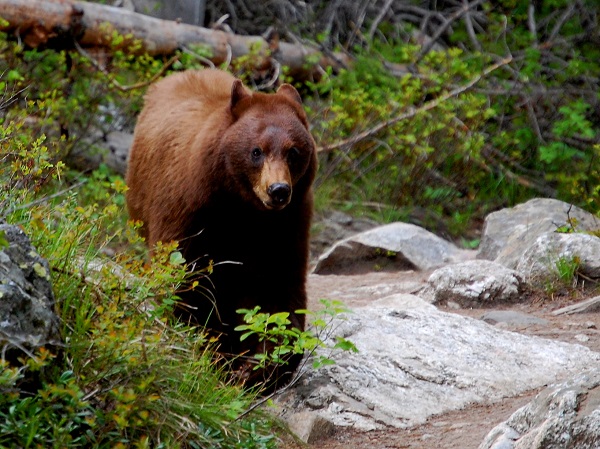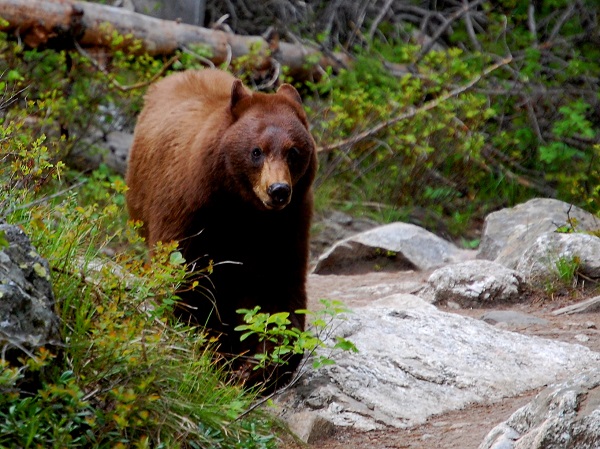
Autumn in the Greater Yellowstone Ecosystem (GYE) is brief compared to other parts of the country. Despite its brevity, there are many exciting phenological changes to take note of. In early September, once the grasses amidst the sagebrush turn from green to gold, you begin to hear the first bugles from bull elk. Bears have entered into a physiological state referred to as hyperphagia, during which they are solely focused on eating. And, of course, you don’t have to be super observant to notice the leaves of quaking aspen, rocky mountain maple, narrowleaf cottonwood, and willow turning yellow, brown, and red. The auditory and aesthetic beauty of these phenomena are certainly worth experiencing, but why do they occur at all?
Elk Bugling
 Throughout much of the year, bull elk (males) live alone or in small bachelor herds with other bulls. Cow elk (females) and their calves live in small, scattered herds for much of the year and rarely interact with bulls outside of autumn. However, during the autumn elk gather in large groups to breed. The breeding season, referred to as the rut, typically lasts from early September to mid or late October. During the rut, bulls will gather harems of cows and calves. One way they do this is by bugling: making vocalizations that attract cow elk that are in estrus. The bugle of a bull elk on a crisp, cold morning is a sound that, for some people, symbolizes wildness. It’s a primordial sound that booms from forests and meadows. Cows and calves also create vocalizations during the rut, though these sounds are less distinctive than the bugle of a bull. Elk are perhaps the most vocal ungulates. Beyond bugling to attract cows, bull elk also bugle to demonstrate their physical fitness, to let other bulls know to stay away from their harem of cows, and to signal to other bulls that they are prepared to spar in battle for the right to mate. If you find yourself in the GYE during September or October, you should go to the edge of a meadow or forest, bring warm layers, and listen while the bugles echo around you. It is a humbling experience.
Throughout much of the year, bull elk (males) live alone or in small bachelor herds with other bulls. Cow elk (females) and their calves live in small, scattered herds for much of the year and rarely interact with bulls outside of autumn. However, during the autumn elk gather in large groups to breed. The breeding season, referred to as the rut, typically lasts from early September to mid or late October. During the rut, bulls will gather harems of cows and calves. One way they do this is by bugling: making vocalizations that attract cow elk that are in estrus. The bugle of a bull elk on a crisp, cold morning is a sound that, for some people, symbolizes wildness. It’s a primordial sound that booms from forests and meadows. Cows and calves also create vocalizations during the rut, though these sounds are less distinctive than the bugle of a bull. Elk are perhaps the most vocal ungulates. Beyond bugling to attract cows, bull elk also bugle to demonstrate their physical fitness, to let other bulls know to stay away from their harem of cows, and to signal to other bulls that they are prepared to spar in battle for the right to mate. If you find yourself in the GYE during September or October, you should go to the edge of a meadow or forest, bring warm layers, and listen while the bugles echo around you. It is a humbling experience.
Hyperphagia
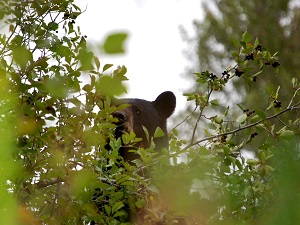 Hyperphagia is a term used to describe the biological state during which bears consume excessive amounts of food. The start of hyperphagia in bears is believed to be triggered by the decreasing photoperiod (or day length) that occurs during autumn. This decrease in day length is a signal to bears that winter is approaching and that they need to begin gaining fat to endure the coming winter, when they enter deep slumber and consume very little, if any, food and water. During hyperphagia the rate and duration of food and water intake increases. In the GYE, bears turn to army cutworm moths, whitebark pine nuts, and ripe berries as staple food sources. But how much fat, you might ask, can a bear actually gain from eating insects, seeds, and nuts? In Jim Halfpenny’s book Yellowstone Bears in the Wild, he wrties that during hyperphagia “weight gain may be as much as three pounds per day. A bear might gain 100 pounds during the month of September alone.” If you are visiting the GYE in the fall, good places to observe bears in hyperphagia include any location that has a healthy population of black hawthorn and service berry plants. Remember that while in bear country it is recommended that you hike in groups of four or more, that you carry bear spray, and that you maintain a distance of 100 yards or more from bears, both so as not to disturb them and so as to keep yourself safe.
Hyperphagia is a term used to describe the biological state during which bears consume excessive amounts of food. The start of hyperphagia in bears is believed to be triggered by the decreasing photoperiod (or day length) that occurs during autumn. This decrease in day length is a signal to bears that winter is approaching and that they need to begin gaining fat to endure the coming winter, when they enter deep slumber and consume very little, if any, food and water. During hyperphagia the rate and duration of food and water intake increases. In the GYE, bears turn to army cutworm moths, whitebark pine nuts, and ripe berries as staple food sources. But how much fat, you might ask, can a bear actually gain from eating insects, seeds, and nuts? In Jim Halfpenny’s book Yellowstone Bears in the Wild, he wrties that during hyperphagia “weight gain may be as much as three pounds per day. A bear might gain 100 pounds during the month of September alone.” If you are visiting the GYE in the fall, good places to observe bears in hyperphagia include any location that has a healthy population of black hawthorn and service berry plants. Remember that while in bear country it is recommended that you hike in groups of four or more, that you carry bear spray, and that you maintain a distance of 100 yards or more from bears, both so as not to disturb them and so as to keep yourself safe.
The Colors of Autumn
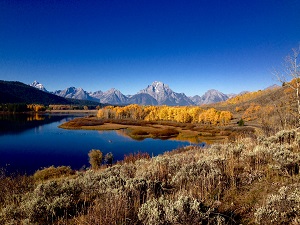 Throughout spring and summer, the leaves of deciduous plants are various shades of bright green. Leaves are green because of the chlorophyll in chloroplasts. Chlorophyll is a molecule that is responsible for photosynthesis, the process by which plants use sunlight to synthesize energy from carbon dioxide and water. Interestingly, chlorophyll absorbs the red and blue wavelengths of the light spectrum, leaving only the green colors of the spectrum to be seen by the human eye, and making leaves look green. It is common knowledge that as summer ends and autumn begins the leaves of many deciduous plants change color. But why? During the transition from summer to fall, the length of daylight decreases and the temperatures get cooler. Just as these changes signal to bears that they need to begin consuming food in preparation for winter, these changes also signal to plants that winter is approaching and that they need to stop photosynthesizing, or stop their food-making process. With a decrease in the food-making process, there is also a decrease in the production of chlorophyll. As the chlorophyll breaks down over time, the green color of the leaf begins to disappear, and the yellow and red colors of the light spectrum become more and more visible to the human eye. In essence, the changing colors of leaves means that a plant is beginning to stop its food-making process and is entering a type of dormancy for winter.
Throughout spring and summer, the leaves of deciduous plants are various shades of bright green. Leaves are green because of the chlorophyll in chloroplasts. Chlorophyll is a molecule that is responsible for photosynthesis, the process by which plants use sunlight to synthesize energy from carbon dioxide and water. Interestingly, chlorophyll absorbs the red and blue wavelengths of the light spectrum, leaving only the green colors of the spectrum to be seen by the human eye, and making leaves look green. It is common knowledge that as summer ends and autumn begins the leaves of many deciduous plants change color. But why? During the transition from summer to fall, the length of daylight decreases and the temperatures get cooler. Just as these changes signal to bears that they need to begin consuming food in preparation for winter, these changes also signal to plants that winter is approaching and that they need to stop photosynthesizing, or stop their food-making process. With a decrease in the food-making process, there is also a decrease in the production of chlorophyll. As the chlorophyll breaks down over time, the green color of the leaf begins to disappear, and the yellow and red colors of the light spectrum become more and more visible to the human eye. In essence, the changing colors of leaves means that a plant is beginning to stop its food-making process and is entering a type of dormancy for winter.
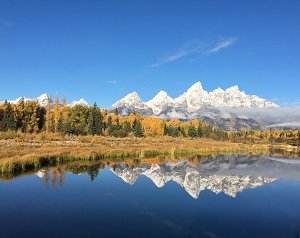 One great way to experience these three seasonal splendors is to participate in a three-day Fall Elk Bugling, Wolves & Bears Expedition with Wildlife Expeditions of Teton Science Schools. During these programs, you’ll have ample opportunity to listen to elk bugle, see bears in hyperphagia, and witness the fall colors across the landscapes of Grand Teton and Yellowstone National Parks. To learn more about the Fall Elk, Wolves & Bears Expedition visit our website at www.wildlifeexpeditions.org or call 307-733-2623.
One great way to experience these three seasonal splendors is to participate in a three-day Fall Elk Bugling, Wolves & Bears Expedition with Wildlife Expeditions of Teton Science Schools. During these programs, you’ll have ample opportunity to listen to elk bugle, see bears in hyperphagia, and witness the fall colors across the landscapes of Grand Teton and Yellowstone National Parks. To learn more about the Fall Elk, Wolves & Bears Expedition visit our website at www.wildlifeexpeditions.org or call 307-733-2623.

